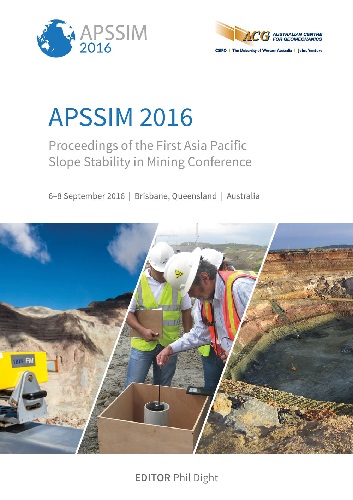Rock fall trajectory field testing, model simulations and considerations for steep slope design in hard rock

|
Authors: Bar, N; Nicoll, S; Pothitos, F |
DOI https://doi.org/10.36487/ACG_rep/1604_29_Bar
Cite As:
Bar, N, Nicoll, S & Pothitos, F 2016, 'Rock fall trajectory field testing, model simulations and considerations for steep slope design in hard rock', in PM Dight (ed.), APSSIM 2016: Proceedings of the First Asia Pacific Slope Stability in Mining Conference, Australian Centre for Geomechanics, Perth, pp. 457-466, https://doi.org/10.36487/ACG_rep/1604_29_Bar
Abstract:
Newcrest Mining Limited open pit operations at Telfer (Western Australia) have excavated steep slopes. Current and future planned mine designs also intend to implement steep slopes in order to maintain profitable ore to waste strip ratios. When not adequately considered in the design process, rock falls can present a significant hazard in open pit mines. The management of rock fall hazards becomes particularly vital for steep slopes. Numerical models are often used to assess the effectiveness of benched slope designs or rock fall barriers to minimise risk to personnel or equipment. Commonly used numerical modelling software and simulation impact theories include: • ‘RocFall’ — two-dimensional lumped-mass impact model (2DLM). • ‘Trajec3D’ — three-dimensional rigid body impact model (3DRB). Numerical models use coefficients of restitution to characterise the amount of energy lost due to the inelastic deformation during the collision of a rock with the slope or bench. The input parameters are vastly different for 2DLM and 3DRB and they are seldom calibrated with any site-specific rock fall case studies or field test data during project feasibility studies, and often remain uncalibrated through the operating life of the mine. In order to best manage rock fall hazards for steep slopes through design, a series of rock fall trajectory field tests were carried out to facilitate the development of calibrated 2DLM and 3DRB numerical models. The calibrated models were then utilised to assess the effectiveness of various slope design geometries. The influence of model selection was found to have a significant impact upon the results. This paper compares rock fall trajectory predictions obtained from calibrated 2DLM and 3DRB models for steep slope designs in hard rock.
Keywords: rock fall, rockfall, slope design
References:
Ashayer, P 2007, Application of rigid body impact mechanics and discrete element modelling to rockfall simulation, PhD thesis, University of Toronto, Canada.
Basson, FRP 2012, ‘Rigid body dynamics for rock fall trajectory simulation’, in Proceedings of the 46th US Rock Mechanics & Geomechanics Symposium 24–27 June 2012, American Rock Mechanics Association, Chicago.
Bosman, JD & Kotze, G 2015, ‘Verification of catch berm effectiveness through the application of 3D fall body dynamics’, in Proceedings of Slope Stability 2015, International Symposium on Rock Slope Stability in Open Pit Mining and Civil Engineering 12–16 October 2015, Cape Town, South Africa.
Budetta, P & Santo, A 1994, ‘Morphostructural evolution and related kinematics of rockfalls in Campania (south Italy)’, Engineering Geology, vol. 36, pp. 197–210.
Chau, KT, Wong, RHC & Lee, CF 1996, ‘Rockfall problems in Hong Kong and some new experimental results for coefficients of restitution’, International Journal of Rock Mechanics, Mining Sciences and Geomechanics, vol. 35, pp. 662–663.
Dadashzadeh, N, Duzgun, HSB, Yesiloglu-Gultekin, N & Bilgin, A 2014, ‘Comparison of Lumped Mass and Rigid Body Rockfall Simulation Models for Mardin Castle, Turkey’, in Proceedings of the 48th US Rock Mechanics & Geomechanics Symposium 1–4 June 2014, American Rock Mechanics Association, Minneapolis.
Ritchie, AM 1963, ‘Evaluation of rock fall and its control’, Highway Research Record 17, Highway Research Board, Washington, pp. 13–28.
Robotham, ME, Wang, H & Walton, G 1995, ‘Assessment of risk from rockfall from active and abandoned quarry slopes’, Institution of Mining and Metallurgy Section A, vol. 10 (Jan–Apr), pp. A25–A33.
Ryan, TM & Pryor, PR 2000, ‘Designing catch benches and interramp slopes’, in WA Hustrulid, MK McCarter & DJA Van Zyl (eds), Slope Stability in Surface Mining, SME, Colorado, pp. 27–38.
© Copyright 2025, Australian Centre for Geomechanics (ACG), The University of Western Australia. All rights reserved.
View copyright/legal information
Please direct any queries or error reports to repository-acg@uwa.edu.au
View copyright/legal information
Please direct any queries or error reports to repository-acg@uwa.edu.au